Manufacturer News
What Do You Get If You Cross A Saab 900 Turbo Cabriolet With A Nissan Figaro?
It’s possible to get a hinny in the equine world, but how did the auto world possibly come up with the Morgan Midsummer? For those with little equine knowledge (and to be honest, I didn’t know that a hinny existed), let’s first of all clear up what a hinny actually is. A male horse (stallion) and a female donkey (a jenny) can get together and produce a domestic equine hybrid called a hinny – a cross between a male horse and a female donkey.
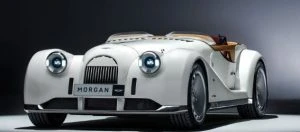
I was more familiar with the flipside of this, where a male donkey (a jack) and a female horse (a mare) got together and produced a mule. I’m not quite sure why I linked a Morgan with the equine world, apart from the obvious connotations of horsepower, but I think it comes down to the Morgan being a really cool modern car that has a beauty that it has all of its own but then has a hint of cars from yesteryear, ones that were also a bit exclusive and cool, even back then.
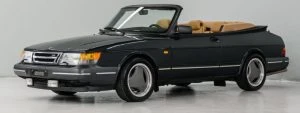
The Saab 900 Turbo Cabriolet is a bit of a stallion. I mean, look at all that exquisite eighties leather used to make its interior and some of the most comfortable seats I’ve ever enjoyed. Then there’s its striking angular styling, cool three-spoke aero mags, black soft-top roof, and the powerful 2.0-litre turbo engine that made this a quick and exciting car. Little wonder, then, that the Saab 900 Turbo Cabriolet, with his angular black physique and soft salt and pepper stone chips, attracted the attention of a lonely but very pretty pale aqua Nissan Figaro. Result… well the modern-day Morgan Midsummer, of course!
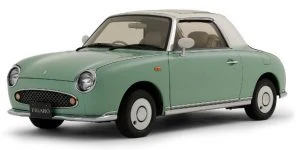
Saab isn’t really dead yet, because the cult following of the 900 and other great Saabs of yesteryear are still being restored and cherished by many a car enthusiast. The Nissan Figaro also has a dedicated following too, with her cute and loveable cabriolet style born back in the early nineties. Morgan, on the other hand, are still in business – very much in the business of making new cars. Their latest project, called the Midsummer, is a brilliant progression of the niche brand’s range of open-top roadsters that span back to the very first model that emerged in 1909/1910 known as the three-wheeled runabout, which was a single-seater that used a 5.2 kW Peugeot twin-cylinder motor. After deciding that a two-seater version was much more inclusive, the little Morgan Runabout became the only car ever to appear in a shop window at Harrods of London.
Morgans are fun! And the Midsummer is no exception. Fifty of these new models will be made, and most of the car will still be hand built. The 2024 Morgan Midsummer is a two-seat open-top sports car that represents the shared vision of Morgan and Pininfarina, who have worked in partnership on this new model to celebrate the timeless beauty of Morgan sportscars. The Morgan Midsummer boasts Morgan’s CX-generation aluminium chassis, and with a BMW 6-cylinder turbo as its power source, this little sportscar will be sure to fly!
In the Morgan, as always, wood is used in its construction, now as a design feature rather than for all-out strength. For the Morgan Midsummer, many layers of teak are used to create the car’s shoulder line and cockpit surrounds. This gorgeous natural look takes around 30 hours to make by hand, and when it comes to the curvaceous and eye-catching body panels, a further 250 hours of literal handiwork are performed for making these beautifully handcrafted pieces. The combination of human love, dedication, and care, which are so easily disregarded in today’s robotic processes, makes this a standout vehicle with elegant sports car lines and huge desirability. This car won’t be thrown away so easily in decades to come.
So what do you get when you cross a Saab 900 Convertible with a Nissan Figaro? A Morgan Midsummer with BMW power!
Ferrari 2024 Le Mans: Two in a Row
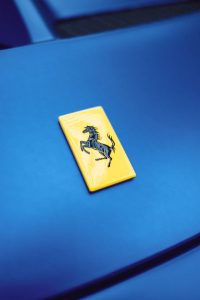
That’s back-to-back for Ferrari at Lemans, having won last year and backing it up again just over the past weekend for 2024. If you look back over the list of winners at Le Mans, there have been numerous times that car marques have won twice in a row, even four or five times in a row, sometimes with the same driver. Only 14 seconds behind the Ferrari, Toyota was nipping at its heels the whole day, er… and night. It’s great to have a red car with the prancing horse back on top, Toyota having won 5 consecutive years running from 2018–2022.
So what makes the Ferrari 499P or Toyota GR010 Hybrid race car so fast? Great aerodynamics, strong reliability, excellent brakes, and epic performance. The Ferrari 499P uses a mid-to-rear internal combustion engine (ICE), as well as a front-mounted electric motor. These two powerplants combine to develop a maximum output of 500 kW to comply with the Le Mans race regulations of 29 Oct 2022. The front-mounted electric motor, rated at 200 kW, draws its necessary electric power from a Formula 1-derived 900 V battery that recharges during deceleration and braking. It provides power at speeds over 190 km/h. The hybrid power is linked and fed though to a seven-speed sequential transmission. The car was clocked just shy of 350 km/h, and the 0–100 km/h time takes about as much time as it does to complete this sentence!

Le Mans 2024 was the 92nd 24-Hour Le Mans endurance race, and the fourth round of the 2024 FIA World Endurance Championship. The race began on 15th June 2024 and ended 16th June 2024 at the Circuit de la Sarthe track in Le Mans, France, which, in its present configuration, is 13.626 km long, making it one of the longest circuits in the world. What makes this such an exciting event is that 85% of the lap time is spent on full throttle. This, of course, puts immense pressure on the engine and the drivetrain’s components, and only cars that can withstand this torrid test of reliability can make it through the race and perhaps even win. Brakes and suspension components also take a lot of abuse, as the race cars must slow from well over 300 km/h to around 100 km/h as quickly and as efficiently as possible to make it round the sharp corner at the village of Mulsanne.
Constant overnight rain created long periods where drivers were forced to drive with caution in the difficult conditions, thus having to limit their top speed at times. Ferrari were able to overcome the wet conditions at Le Mans 2024 to beat Toyota and win the 24-hour race, yet it was another Ferrari 499P that took out third place as well. It was as much a shout-out to the incredible skill of the drivers as it was to the marque. Porsche took out fourth position, coming just over a second behind Ferrari’s number 51 car, while Toyota’s number eight car finished an impressive fifth.

Introducing The Jetour
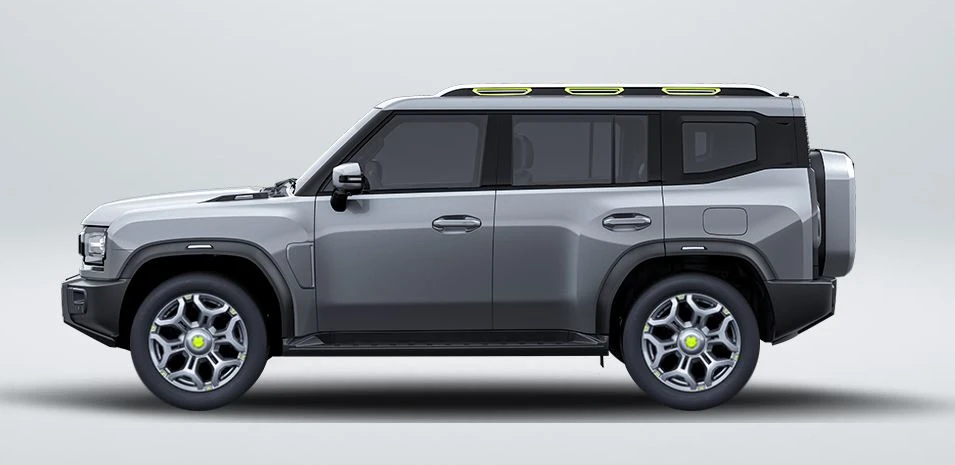
I’ve always loved the exterior of the Land Rover Defender, whether old or new. Its boxy shape and rugged appearance are perfectly crafted for off-roading. The short front and rear overhangs are just perfect for clearing steep entry and exit points on a slope. Of course, there is also the legendary Defender’s 4WD powertrain that is the rock of what makes this an immensely capable 4×4 off-road machine. However, there is another vehicle coming to Australia with that same chunky, boxy shape and talented off-road skills. This new machine comes to us from China and will be available to buy down under in 2025. Let’s take a closer look, and by this, I mean you’ll need to look really closely to make sure it is a Jetour and not a Defender. A big hint is to read the brand name that runs across the front of the bonnet!
It is said that we all have a double of ourselves somewhere in the world (I know I do). This double basically looks like us. Land Rover Defender’s double or doppelganger (German for “double walker”) would surely have to be the new Jetour. The Jetour is a vehicle that was designed to be a luxury crossover brand in 2018 and is the creation born from the Chery Holding Group, often known simply as Chery. Chery is an automotive group currently based in the eastern Chinese city of Wuhu. Born in 1997, Chery has grown and developed in a diversified manner with automobiles as its primary business. Over time, Chery have created automobiles, gotten involved in automotive parts, finance, property and modern services. Chery now has over 300 member-enterprises; these include Chery Automobile, Chery Commercial Vehicle, Chery Jaguar Land Rover, Chery Finance and Chery Technology.
The Jetour T2 large off-roader does look really good in the metal, with its square boxy body shape, bold wheel arches and big rubber, high ground clearance, a swinging tailgate with a spare tyre on the outside, big solid bumpers, and an interior that won’t mind getting dirty from an adventure Outback.
Similar again to how Land Rover has designed its latest Defender, the 2024 Jetour T2 is built around a monocoque body, which is a design that offers loads of structural rigidity and stiffness for tackling the rigours of serious off-roading. The monocoque body is the perfect solid foundation for the Jetour T2 4×4’s advanced all-independent chassis. An independent suspension means that all four wheels can drop and ride over large obstacles individually and independently of what the other three wheels are doing at the same time. This enhances the ability to obtain maximum traction at each wheel, perfect for progressing through tricky and slippery terrain.
The new Jetour will come with the option of either a 1.5-litre or a 2.0-litre turbo petrol engine to power the 4×4, and the engine’s power is sent through a seven-speed dual-clutch automatic transmission for ensuring optimum engine torque is harnessed at all times. Having a ground clearance rated at 220 mm, and with the engine’s drive sent to all four wheels via the full-time 4×4 system, this is an exciting new off-road SUV for the Adventurer needing a new vehicle to get them to a remote location.
We’re looking forward to it, and be sure that we’ll review it fully when it makes it over here.
News with a French Flavour

So what’s bubbling on the stove in France? Here are some new French cars soon to be coming onto the market. These models will definitely be sold in Europe, hopefully making their way south to roll onto our showroom floors.
Renault 5
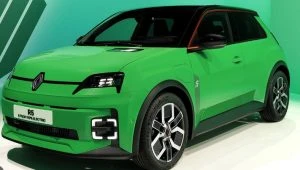
The all-new Renault 5 is back! This is a cool-as retro-inspired EV hatchback that has captured styling from the old Renault 5, embedding it into the new car’s design and detailing. Though a throwback to the iconic Renault 5 of the 1970s–1980s, the new wee car packs plenty of clever technology under its skin.
The interior is fresh and inspiring, and its clever infotainment system is integrated with Google services. The car’s two-step dashboard looks incredible, while the denim-like trim works nicely both as visual and tactile stimulation. The seats are made from recycled plastic bottles, and there are plenty of bright colour schemes for the upholstery and interior. You can even get a little wicker basket to sit in the passenger footwell for carrying your baguette! All the controls are nicely wrapped around the driver, and the new Renault 5 gets a 10.0-inch infotainment screen and a 7.0-inch digital driver’s display.
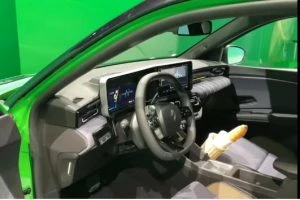
This is a direct alternative to the MG 4 and BYD Dolphin, as it boasts two battery options and a range of up to 390 km. Like the old one, this is front-wheel-driven, and there are three levels of power output to choose from. Entry-level cars have 71 kW, enabling it to run the 0–100 km/h dash in around 12 seconds. The 92-kW version performs the same sprint in 9.0 seconds. And the top of the range 112-kW version sees the little hatchback making it in around 8 seconds. There is even a suggestion that there will be a hot-hatch version of the new little Renault 5, known as the Alpine A290. So, for those looking for sizzling acceleration, this will be worth the wait.
A choice of two battery packs is available for powering the Renault 5’s electric motor. A 40-kWh pack is great for city commuting. There is also a larger 52-kWh battery pack, which gives you a further range. Both battery options will charge from 15% to 80% in around 30 minutes on a DC fast charger.
The new Renault 5 EV Hatch goes on sale in France in September of this year, where it’ll cost around £22,000 in the UK. Isn’t it great to see it back?
Peugeot 5008
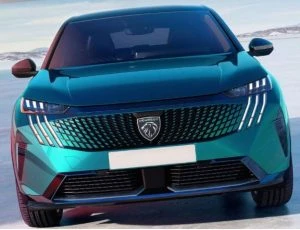
After a seven-seater EV SUV? There aren’t too many of these available; however, the new Peugeot 5008 boosts the options with its E version.
With similar styling to the E-3008, the Peugeot E-5008 shares parts with that car. Snazzy slim headlights are neatly hidden below the bonnet line, along with the car’s signature Peugeot three-claw LED DRLs. Side on, the Peugeot E-5008 is a boxy SUV, hinting towards the generous interior dimensions that are found inside.
The new interior styling and infotainment technology is brilliant. In fact, the Peugeot E-5008 has one of the most stylish and distinctive interiors we’ve seen in cars for a very long time. So, if that hasn’t pricked your ears up, then I’m not sure what else will. The multi-layered dash is wrapped in a groovy grey fabric, the major controls are angled towards the driver, and sitting proudly on top of the dashboard is a massive curved 21-inch screen that houses both the digital driver’s display and the infotainment system. The latest generation of Peugeot’s i-Cockpit system is incorporated into the style and function of the new screen.
With all seven seats in place, you have 259 litres of boot space to put your shopping bags into. A massive 748 litres of luggage space is available with the third row folded down. The Peugeot E-5008 can be had with a 98-kWh battery that is paired to a 172-kW electric motor. This is plenty of power with an equally impressive 650 km range. Then there is the 157-kW motor available, with its 73-kWh battery pack and a slightly shorter travel range. At the top of the tree sits a dual-motor Peugeot E-5008 model with close to 240 kW of power on tap. Its 73-kWh battery is said to provide this model with a range of around 500 km.
The Peugeot 5008 is also available as a hybrid version. Its rather smooth 102-kW petrol engine is mated to a six-speed dual-clutch automatic gearbox, and there’s an added electric motor to boost power and efficiency.
A plug-in hybrid joins the gang in 2025. This will use a 112-kW petrol engine paired to a 90-kW electric motor. This combined power output is nice and strong, while also making this PHEV capable of covering 75 km on electric power alone.
Citroen e-C3
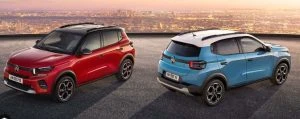
The new Citroen e-C3 has been revealed, and it is an affordable electric SUV boasting up to 315 km of range.
The e-C3 is a funky wee vehicle that is said to be a very affordable buy. It uses an 85-kW electric motor to power the front wheels, capable of propelling the car from 0 to 100 km/h in around 11–14 seconds, depending on the model.
The Citroen e-C3’s interior is comfortable, with some cool-looking fabric on the dash. The two-spoke steering wheel has that funky bit of French flair we all love. To keep the cost down, entry-level models have a mount for your phone instead of a touchscreen, which allows you to access satellite navigation, the radio, and music streaming in this way. All other models have a 10.25-inch touchscreen with all the goodies, and all cars have a classy digital driver’s display.
When these models make it Down Under, we’ll give them a full write-up in our car reviews pages, so if you’re interested, come back later for more.